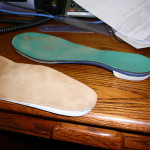Custom molded orthotics 3
Custom Molded Orthotics 3
What is so special about custom orthotics and what is done to them that makes them work? Why are they so expensive? These are all great questions that you should ask. The first step in making custom orthotics is the evaluation of your foot. Your Podiatrist will evaluate your foot for a plethora of positional deformities such as pronation, supination, forefoot valgus, forefoot varus, heel varus, and valgus. Also, the flexibility of your numerous joints is taken into consideration regarding orthotic evaluation. A standing exam and a walking gait exam are performed. Remember there are 33 joints in your foot and the flexibility or rigidity of your joints plays an important role. Once the doctor has an understanding of your foot type, he or she may decide an x-ray is important. For example, an x ray is the best way to tell if you have arthritis or a heel spur or plantar fasciitis, your local “expert” at the running store can not take an x-ray and interpret one. Also, an x ray will tell us if you have a stress fracture and the answer to your pain is not an orthotic but a cast or boot. Once a proper diagnosis is made then the patient’s foot shape is captured.
- standing forefoot evaluation
- Hindfoot evaluation
- stiff vs flexible orthotics
- stiff and flexible orthotics
There are 3 different ways to capture the shape of one’s foot. First is a plaster slipper cast mold ( today there are available fiberglass slipper socks that get great molds). The second method is a foam mold. I am not a big fan of the foam, because you lose accuracy in the shape of the foot. The 3rd and most accurate way is a 3-D scan of the foot. This is the preferred method at the Advanced Foot And Ankle Center Of San Diego. The reason is that it is the most accurate method and it gives us the most precise measurements Stay tuned for part 4 of this series.




